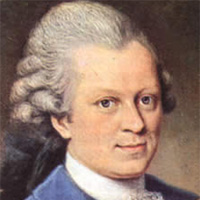Gotthold Ephraim Lessing - Biography and Works
Gotthold Ephraim Lessing (1729-1781) was the leading dramatist and literary theorist of the German Enlightenment, particularly noted for his Laokoon 1766 in which he discusses the relation between poetry and the plastic arts. In his aesthetic writings, he opposed the constraints of convention implicit both in the ideals of French classicism and in neoclassical idealization of the art of ancient Greece.

Gotthold Ephraim Lessing
In his theological writings, he rejected orthodox theology, arguing that historical events (like those narrated in the gospels), are contingent and that the accounts of them cannot be absolutely reliable. For these reasons they cannot form an adequate basis for faith. Unlike his friend Moses Mendelssohn, he believed in the overall progress of mankind and, taking up a theme anticipated by Tertullian and Joachim a Fiore, he saw the history of mankind as an educational process towards an ideal limit of perfection. Die Erziehung des Menschengeschlechts 1777-80 (The education of the human race) is a brief statement of this outlook. Interpreted in this way, the hope of religious believers had a foundation. His eloquent attacks on narrow-minded orthodoxy, inspired in part by his reading (and translation) of theologically undogmatic British writers like Shaftesbury and Hutcheson, exerted a powerful influence, and so did his fervent plea for religious toleration and the universal brotherhood of man in his play Nathan the Wise (1779) and other writings.
Lessing is a mimetic critic. He goes on to formulate the fundamental difference between sculpture and painting, and poetry. His idea of painting and poetry seems to have influenced by Horace who did not find long gap between these two types of art. In 1759, Lessing published some masterly prose fables, largely social criticism, and with them an essay on the fable form itself, in which he formulated the particular laws of the genre by analyzing its didactic and allegorical structure.
